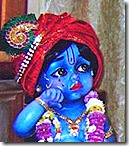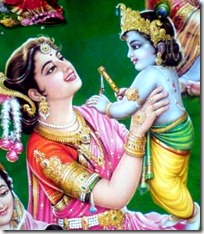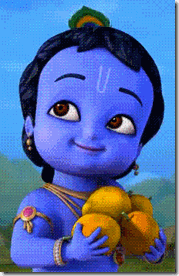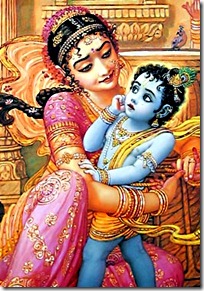 “It is natural that when a child becomes angry he can begin crying with false tears in his eyes. So Krishna did this, and biting His reddish lips with His teeth, He broke the pot with a stone, entered a room and began to eat the freshly churned butter.” (Shrila Prabhupada, Shrimad Bhagavatam, 10.9.6 Purport)
“It is natural that when a child becomes angry he can begin crying with false tears in his eyes. So Krishna did this, and biting His reddish lips with His teeth, He broke the pot with a stone, entered a room and began to eat the freshly churned butter.” (Shrila Prabhupada, Shrimad Bhagavatam, 10.9.6 Purport)Beautiful Mother Yashoda, sitting peacefully, doing her household chores, was one day approached by her beloved son, her cherished darling who was the delight of Vrindavana
 A pot of milk boiling over in the kitchen was what caused Mother Yashoda to leave the scene. Her prioritization makes perfect sense. How long does it take to turn down the heat on the stove? Just get up for a second, fix the situation and then return to where you were. Plus, she had just interrupted her work to tend to Krishna, so hopefully the young child would understand that a moment’s interruption is not the end of the world. But Shri Krishna wanted exclusive devotion, for that is what He offered to His mom. He was not distracted by other obligations within the home, though He didn’t have any as a child. Regardless, a restless child is known to jump from one play activity to another. A blessed child is the one who knows the parent’s level of affection and reciprocates by allowing them to offer their love as often as possible. Krishna’s insistence that Mother Yashoda stop churning butter was actually for her benefit, as she was thinking about her beloved child at the time anyway.
A pot of milk boiling over in the kitchen was what caused Mother Yashoda to leave the scene. Her prioritization makes perfect sense. How long does it take to turn down the heat on the stove? Just get up for a second, fix the situation and then return to where you were. Plus, she had just interrupted her work to tend to Krishna, so hopefully the young child would understand that a moment’s interruption is not the end of the world. But Shri Krishna wanted exclusive devotion, for that is what He offered to His mom. He was not distracted by other obligations within the home, though He didn’t have any as a child. Regardless, a restless child is known to jump from one play activity to another. A blessed child is the one who knows the parent’s level of affection and reciprocates by allowing them to offer their love as often as possible. Krishna’s insistence that Mother Yashoda stop churning butter was actually for her benefit, as she was thinking about her beloved child at the time anyway.The sweet mother had composed songs about His many pastimes, which included the slaying of wicked characters that had travelled to Gokula for nefarious purposes. Somehow Krishna managed to survive the attack of a witch named Putana, who had disguised herself as a beautiful woman coming to nurse the young child. The innocent Krishna also survived the attacks of a giant whirlwind and the breaking of a cart He was resting on during infancy. Trouble seemed to lurk around Krishna, yet He was unbreakable, giving delight to the residents through His invincibility.
It is natural for a mother to think of her beloved son, but with Yashoda she was so attached that she would compose songs on the fly and sing them out loud for pleasure. Since Krishna awoke and came on the scene during the time the mother was working and singing, we can guess that He was able to hear these songs, that the mother’s dip into the transcendental pool of nectar made up of her son’s pastimes became known to the object of service.
 How was this possible? How could a young child even understand what His mother was singing about? The child Krishna was none other than the Supreme Personality of Godhead. That God can come to earth and play the role of an ordinary human being, that of a tiny infant no less, is very difficult to accept for many well-intentioned people. Lord Shiva
How was this possible? How could a young child even understand what His mother was singing about? The child Krishna was none other than the Supreme Personality of Godhead. That God can come to earth and play the role of an ordinary human being, that of a tiny infant no less, is very difficult to accept for many well-intentioned people. Lord ShivaOne time Lord Shiva was anxious to hear about Lord Rama
Not satisfied, Lord Shiva then came upon the scene to get a quick glimpse of some of Rama’s activities. He did so very quietly so that no one would know he was there. If people found out he was watching Rama, then maybe Rama’s true position as the Supreme Lord would be revealed, which was not the purpose at the time. Seeing Rama, who was in a pitiful condition at the time because of His wife Sita having gone missing, Mahadeva felt tremendous happiness, so much so that he was dancing and of general good cheer. Mahadeva was happy just to see Rama. He paid no attention to exactly what the Lord was doing, for God works in mysterious ways, especially when He appears as an avatara
Bhavani was quite puzzled by this. She knew of Rama’s glory, but couldn’t understand how He could be the Supreme Lord and appear on earth as a human being at the same time. Moreover, how could God be lamenting the loss of anyone? Why was her husband now so thrilled just upon seeing Him? Therefore she kindly asked Lord Shiva to explain further, to settle her doubts, and Mahadeva replied that the person she was watching was indeed the Supreme Lord and that He is never subject to illusion or the forces of material nature, despite what the external appearance may indicate. Everything is carefully arranged by the Lord to fulfill a purpose.
 In the same vein, Lord Krishna’s interruption of Mother Yashoda during her churning of butter also served a purpose. Krishna’s appearance in Vrindavana gave pleasure to those truly deserving of it, those who had no other desire in life. The qualification of “pure” is often placed in front of devotion to distinguish the highest religious system versus other kinds. The purity is measured from the ultimate desire of the practicing individual. For instance, we may be devoted to someone, but there may be an underlying motive in the background. Pure devotion is present when there is no other desire except to remain devoted to the Supreme Lord in love.
In the same vein, Lord Krishna’s interruption of Mother Yashoda during her churning of butter also served a purpose. Krishna’s appearance in Vrindavana gave pleasure to those truly deserving of it, those who had no other desire in life. The qualification of “pure” is often placed in front of devotion to distinguish the highest religious system versus other kinds. The purity is measured from the ultimate desire of the practicing individual. For instance, we may be devoted to someone, but there may be an underlying motive in the background. Pure devotion is present when there is no other desire except to remain devoted to the Supreme Lord in love.As an example, in his Gitavali Goswami Tulsidas
The residents of Vrindavana had the same level of purity, for Krishna was everything to them. Just the fact that the Supreme Lord descended to earth and remained in their land for such a long time shows that they could not have harbored any other desire in mind. When Mother Yashoda went to tend to the milk that was boiling over, Krishna became angry and broke the pot full of the butter she had so nicely churned. Faking tears in his eyes because of his anger, Krishna then went to another room and ate the butter. So not only did he spoil her work, but he began eating the butter that was to be used for other things.
In the aftermath, Yashoda chased Krishna with a stick and then tied Him to a mortar as punishment. The fact that Krishna would allow this to happen shows just how much He loves His mother. Celebrated thereafter as Damodara, Krishna is honored every year in the month ofKartika with candles offered by the devotees
 From Krishna’s behavior we see that devotion to God on the highest level flows in both directions. Just as the devotee is anxious to see Krishna, the Supreme Lord is eager to see the devotee, so much so that He’ll get angry if the worshiper’s attention is diverted elsewhere, even for a moment. Though Krishna broke the pot of butter in anger, He actually did Yashoda and countless future generations of listeners a huge favor. He let Yashoda know that He was not happy when she left Him, that He accepted and appreciated her love more than anyone else’s. It is not surprising therefore that such a sweetheart of a son would be honored by all types of transcendentalists.
From Krishna’s behavior we see that devotion to God on the highest level flows in both directions. Just as the devotee is anxious to see Krishna, the Supreme Lord is eager to see the devotee, so much so that He’ll get angry if the worshiper’s attention is diverted elsewhere, even for a moment. Though Krishna broke the pot of butter in anger, He actually did Yashoda and countless future generations of listeners a huge favor. He let Yashoda know that He was not happy when she left Him, that He accepted and appreciated her love more than anyone else’s. It is not surprising therefore that such a sweetheart of a son would be honored by all types of transcendentalists.With so many engagements available to the conditioned soul residing in the material world, there are many avenues to take that promote forgetfulness of Krishna. But if there is a sincere desire to remain connected with Him - a wish best revealed by regularly chanting
In Closing:
In anger young Krishna cried tears that were fake,
Broke pot and butter to other room did He take.
Yashoda’s attention innocently diverted,
Tended to boiling milk pot so that crisis averted.
For Krishna’s stubborn anger there was no need,
Mother to Him milk would surely again feed.
Nevertheless showed anger because company she forsook,
Protested separation by the churned butter He took.
The pastimes with Krishna and His mother so lovely,
Hearing them gives heart delight always so timely.